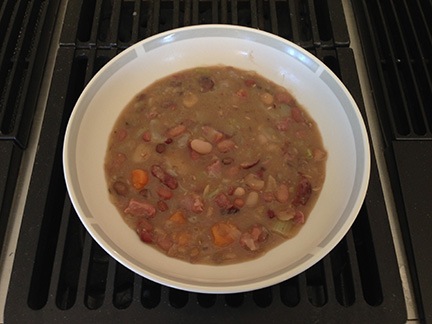Very easy, very tasty.
One of the great things about living near Wenatchee, Washington’s “Apple Capital,” is the wide availability of fresh-picked apples each autumn. Not only am I able to buy local apples direct from packing companies like Stemilt’s Bountiful Fruit store in North Wenatchee (which ships, by the way), but I can often get out in an orchard and pick the less marketable fruit left behind. Indeed, just last week, after dropping off some passengers for a meeting at an orchard, I walked through an organic gala apple block and picked a half dozen apples that were just too small to pick. (I get cherries and pears like this, too.)
I was invited to dinner at a friend’s house the other day and told my host I’d bring apple crisp. I wanted to make just enough for him and his three guests. So I found a recipe that was easily scalable. It came out great with those galas. So good that I made myself a single serving of hot apple crisp the next day for breakfast.
Here’s my scalable recipe. This will serve one or two.
Ingredients:
- 1 medium or large apple. I used gala.
- 2 tablespoons raisins (optional). I didn’t use them. I really don’t care much for raisins, but they do go good in apple crisp.
- 2 teaspoons sugar. I use raw cane sugar.
- 1/4 teaspoon cinnamon
- Pinch of salt (optional).
- 2 tablespoons light brown sugar. Packed, of course.
- 2 tablespoons oatmeal. Do not use instant oatmeal. Ever. (Ick.)
- 1 tablespoon flour
- 1 tablespoon cold butter. I used frozen butter cut into small pieces.
- Additional butter to butter pan.
Instructions:
- Preheat oven to 350°F.
- Butter a small baking dish and set aside.
- Cut up the apple and place it in a small bowl. You can cut it however you like; keep in mind that the smaller the pieces, the faster they’ll cook.
- Add raisins (if you’re including them), sugar, cinnamon, and salt (if you’re including it). Toss to coat apples with sugar and cinnamon.
- Place apple mixture in the prepared baking dish.
- Mix together brown sugar, oatmeal, flour, and butter pieces. Using your fingers, blend until the butter is in very small pieces and well mixed in. This could take about 2 minutes.
 Sprinkle the topping over the apples.
Sprinkle the topping over the apples.- Bake until apple is tender, 30 to 40 minutes, depending on the size of the apple pieces. (If you used a glass baking dish, you should see the apples bubbling in their juices.)
- Cool for at least 15 minutes before eating.
This is amazingly delicious with coffee for breakfast or with vanilla ice cream for dessert.

 Sprinkle the topping over the apples.
Sprinkle the topping over the apples. Baked brie is one of my favorite appetizers — and something I like to make for guests when having a dinner or cocktail party. I made it the other night for dinner at a friend’s house; I did all the prep at home and baked it in her oven. It was the second time she’d had it and she asked me to write down the recipe. I thought it would be easiest to just share it here. As you’ll see, it’s very easy.
Baked brie is one of my favorite appetizers — and something I like to make for guests when having a dinner or cocktail party. I made it the other night for dinner at a friend’s house; I did all the prep at home and baked it in her oven. It was the second time she’d had it and she asked me to write down the recipe. I thought it would be easiest to just share it here. As you’ll see, it’s very easy. 1 package Pillsbury Crusty French Loaf (or similar). You should be able to find this in the refrigerator section of your supermarket.
1 package Pillsbury Crusty French Loaf (or similar). You should be able to find this in the refrigerator section of your supermarket. I know winter is over, but that doesn’t stop me from making soup. Soup, after all, is comfort food, and we can all use a little comfort now and then — some more than others.
I know winter is over, but that doesn’t stop me from making soup. Soup, after all, is comfort food, and we can all use a little comfort now and then — some more than others. The other day, I made 15-bean soup, a great, hearty dish, especially good on cold days.
The other day, I made 15-bean soup, a great, hearty dish, especially good on cold days.